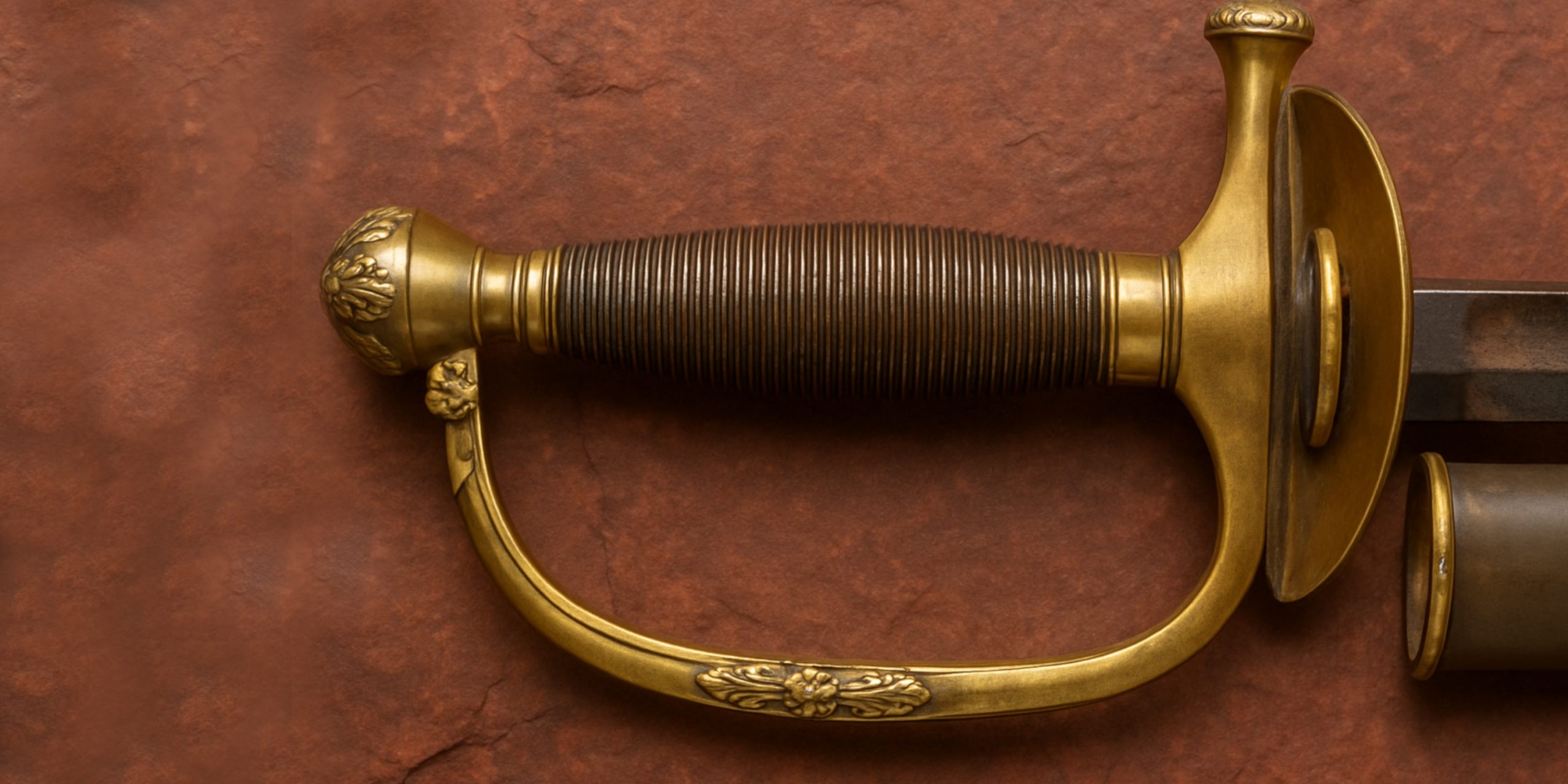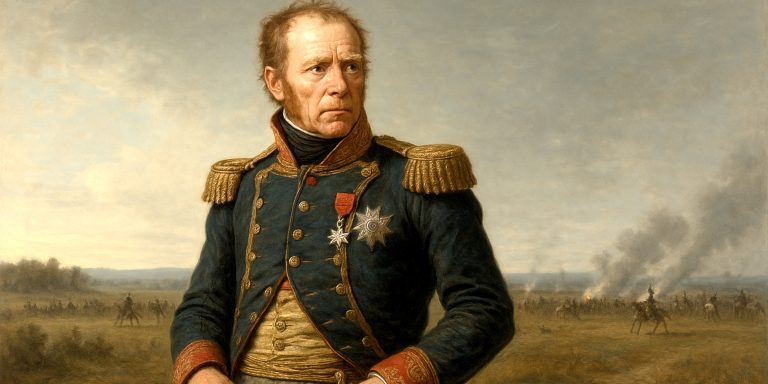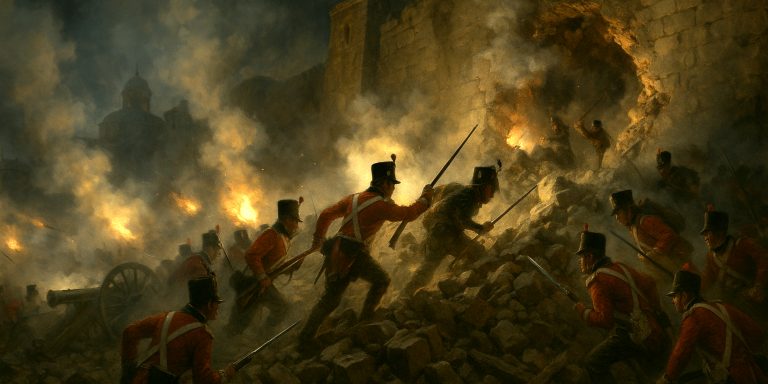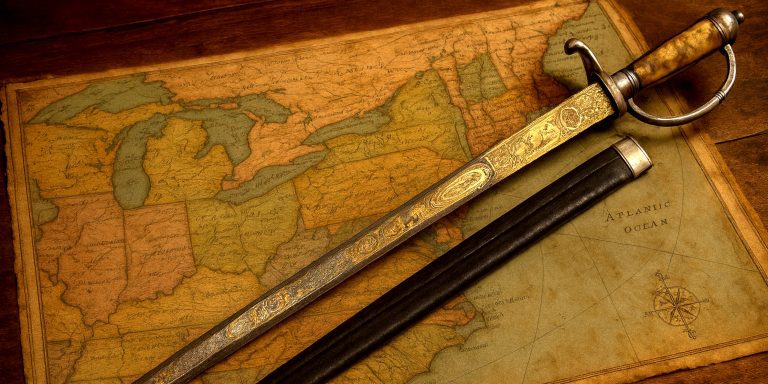
The US Model 1840 Foot Officer’s sword marks an important transitional step in American military arms. Introduced around 1840, it armed officers during the Mexican–American War and still appeared in the opening years of the Civil War. Unlike the mass-issued NCO sword of the same year, this officer’s version was produced in smaller numbers, often with finer decoration, patriotic etching, and a folding guard for comfort.
Specifications
| Aspect | Details |
|---|---|
| Blade | Straight, single-edged, cut-and-thrust profile with long fuller and short false edge |
| Length | Around 31–32 inches |
| Hilt | Gilt brass with urn pommel, knuckle bow, and double shell guard (rear guard folds on officer models) |
| Grip | Wood core, leather wrap, wire binding or imitation silver wire on high-grade pieces |
| Scabbard | Leather with brass mounts most common, steel scabbards on premium versions |
| Decoration | Etched motifs including floral scrolls, US shields, eagles, and liberty caps |
History and Evolution
- Adoption: Designed for foot officers, influenced by French and Prussian patterns of the early 19th century.
- Service Use: Carried in the Mexican–American War and sometimes in early Civil War service before being replaced by the Model 1850 Foot Officer’s sword.
- Replacement: The M1850 pattern, lighter and with a slightly curved blade, became the Civil War standard.
- Notable Figures: Some senior officers, including General Ambrose Burnside, were photographed with the M1840 Foot Officer’s sword.
Advantages and Disadvantages
Advantages
- Strong thrusting blade with credible cutting ability.
- Officer-grade finish with gilt hilts and etched blades.
- Scarce compared with enlisted models, which enhances collecting interest.
Disadvantages
- Replaced quickly by the M1850, limiting long-term service use.
- Straight blade lacked the cutting power of curved sabres.
- Variation in maker standards can complicate matching swords with original scabbards.
Comparison with Similar Weapons
| Model | Era & Role | Blade | Guard & Grip | Key Difference |
|---|---|---|---|---|
| M1840 Foot Officer | 1840s officer sidearm | Straight cut-and-thrust | Gilt brass, folding rear shell | Transitional pattern, quickly outdated |
| M1850 Foot Officer | 1850s–Civil War | Slight curve, lighter | Brass guard with openwork | Standard officer sword of the Civil War |
| M1840 NCO Sword | 1840s enlisted | Straight, plain finish | Cast brass grip | Common, plainer, no etching |
| M1840 Heavy Cavalry Sabre | Cavalry combat | Strongly curved, heavy | Three-branch guard | Mounted shock weapon, not an officer’s dress sidearm |
| M1832 Foot Artillery | Earlier infantry/artillery | Short, gladius-like | Brass hilt, no shell guard | Precursor design, very different handling |
Legacy
The M1840 Foot Officer’s sword is valued as a rare transitional weapon that bridges early militia styles and the more standardised officer swords of the mid-19th century. While overshadowed by the M1850 during the Civil War, its scarcity today makes it appealing to collectors and museums.
Where to See One
- Smithsonian National Museum of American History holds catalogued examples.
- Private collections and military museums in the United States often feature the M1840 in exhibitions on the Mexican–American War and Civil War.
Collector’s Guide
Key Features to Check
- Maker Marks: Commonly Ames and Horstmann.
- Etching: Floral and patriotic motifs, condition of frosting and gilt critical for value.
- Guard and Grip: Folding shell guard intact, tight hilt assembly.
- Scabbard: Leather with brass mounts typical, steel scabbards on higher-end swords.
- Provenance: Named or presentation swords with officer history command premiums.
Condition Issues
- Blade pitting or loss of etching detail.
- Grip leather shrinkage or replacement wire.
- Folding guard looseness or breakage.
- Scabbard seam splits or missing mounts.
Auction Price Guide
| Condition | Price Range |
|---|---|
| Worn service example | £650–£1,000 |
| Good condition officer example | £1,200–£2,500 |
| Presentation grade | £2,500–£5,000+ |
| Named or historically important example | £8,000+ |
Care and Authentication
- Preserve any provenance documents, as they can multiply value.
- Study grip wire patterns and guard styles to distinguish from militia and M1850 variants.
- Avoid over-polishing; stabilise leather and gilt with gentle conservation methods.
Quick Reference
- Introduced: Circa 1840
- Service: Mexican–American War, early Civil War
- Key Feature: Straight blade, folding gilt shell guard
- Collecting Appeal: Scarce compared with M1840 NCO and M1850 officer swords
- Value: £650 for basic examples, £8,000+ for historic or presentation swords



